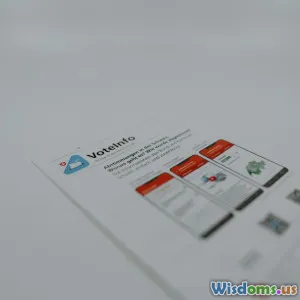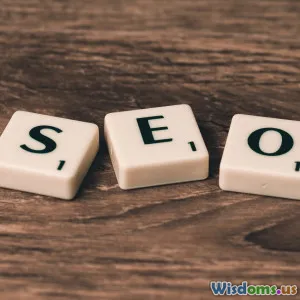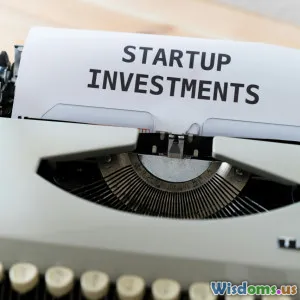
What I Learned Failing My Way to a Six Figure Business
7 min read Discover how embracing failure paved the path to building a thriving six-figure business and the lessons learned along the way. (0 Reviews)
What I Learned Failing My Way to a Six-Figure Business
Introduction: The Hidden Power of Failure
Failure often carries a stigma—seen as a dead end or a sign of incompetence. But what if failure is actually the stepping stone to success? My journey from repeated setbacks to building a six-figure business taught me more about entrepreneurship, resilience, and growth than any success story alone. This article explores the lessons I learned while failing my way to a profitable enterprise, illustrating how embracing failure can transform ambitions into achievements.
The Reality of Failure in Entrepreneurship
Entrepreneurship isn’t a straight path; it’s more akin to a rugged trail strewn with obstacles. Statistically, nearly 90% of startups fail, according to data from the Small Business Administration. But failure isn’t synonymous with the end. Instead, it's a critical component of creative problem-solving and strategic learning.
Failures aren’t just random misfortunes but valuable feedback from the market, operations, and management decisions.
Lesson 1: Resilience is Your Greatest Asset
Early in my business, I launched a product that didn’t resonate with my target market. Instead of immediate abandonment, this failure forced me to double down on understanding customer needs. Like Nike’s famous quote, "Just do it," perseverance hardened my resolve. Resilience helped me navigate emotional lows and pushed me to iterate relentlessly.
Lesson 2: Adaptation is Non-Negotiable
Failure showed me the importance of adaptability. When my first product failed, pivoting based on customer feedback and market research was vital. I moved from offering a generic service to a niche, customized solution. This shift dramatically improved customer acquisition and retention rates. Rapid adaptation prevented stagnation and opened doors to innovation.
Lesson 3: Failure Refines Strategy
Throwing spaghetti on the wall to see what sticks may work in theory, but a refined strategy grounded in data and analysis is far more effective. Each failed campaign or partnership illuminated what didn’t work and revealed underlying causes. This data-driven approach allowed me to cut losses sooner and double down on initiatives with proven returns. For example, by tracking conversion rates and customer behavior, I optimized marketing spend and dramatically increased ROI.
Embracing Failure: Transforming Mindsets and Business Practices
Psychological Barriers and Reframing Failure
Accepting failure requires reshaping mindset—a transition from viewing failure as shame to seeing it as a learning tool. Carol Dweck’s research on growth mindset clarifies that individuals who view abilities and intelligence as malleable are more likely to persevere through challenges.
Changing my interpretative lens regarding failure also entailed celebrating small wins alongside identifying bottlenecks, which helped maintain motivation and focus.
Cultivating a Culture that Welcomes Failure
In scaling my business, nurturing a team culture that embraces failure dramatically accelerated our innovation cycle. By openly discussing failures without blame, we encouraged experimentation and cross-functional learning. For instance, an unsuccessful product feature developed by the tech team sparked ideas for a completely new solution, eventually generating significant revenue.
Practical Tools to Learn from Failure
- Post-Mortem Analyses: After every failure, conducting structured reviews to identify root causes.
- Customer Feedback Loops: Using surveys and interviews to understand customer pain points that failures revealed.
- Minimum Viable Product (MVP) Strategy: Testing core business concepts quickly and inexpensively before full investment.
Turning Failure into a Six-Figure Success: Real-World Impact
By internalizing these lessons, I transformed not only my mindset but also my approach to building a sustainable business. From initially barely breaking even, I reached six figures by the third year, with revenue growth averaging 40% year-over-year.
Key Milestones Along the Way
- Pivoting product focus to a niche market increased customer lifetime value by 30%.
- Investing in data analytics led to a 50% improvement in lead conversion.
- Building a resilient, failure-embracing company culture reduced employee turnover by 25%, enhancing productivity.
Inspirational Stories to Keep in Mind
- J.K. Rowling: Rejected by multiple publishers before "Harry Potter’s" unprecedented success.
- Thomas Edison: Thousands of unsuccessful attempts before inventing the practical incandescent light bulb.
These exemplify how perseverance and learning from failure are universal success catalysts.
Conclusion: Redefining Success Through the Lens of Failure
Failing my way to a six-figure business imparts an essential lesson: failure isn’t the opposite of success but an integral part of it. Each misstep provided actionable insights, cultivating resilience, strategic agility, and an adaptive culture. Embracing failure transforms it from a feared endpoint to a powerful catalyst for growth.
If you’re on your entrepreneurial journey, recognize failure as your instructor, not your enemy. Analyze it, adapt to it, and persevere. Success will follow those who fail smartly and keep moving forward.
"Success is not final, failure is not fatal: It is the courage to continue that counts." – Winston Churchill
Let your failures fuel your journey.
Rate the Post
User Reviews
Popular Posts





















